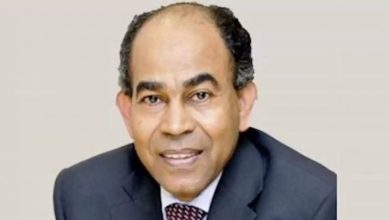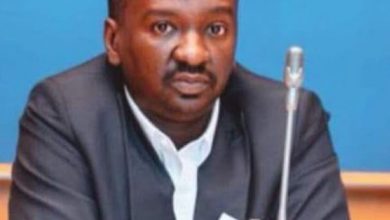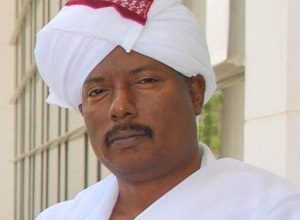Abdul Aziz al-Hilu: How the Sudan People’s Liberation Movement Let Him Down in the Comprehensive Peace Agreement (2005)

By Abdullah Ali Ibrahim
Summary
(The ongoing war in Sudan represents an extreme case of arrogance in wielding arms and the chaos that follows. Even those who initially took up arms for a just cause have not been spared from this chaos. Armed struggle does not stop at freeing oneself from the initial oppressor; rather, it extends to resolving internal disputes within the movement itself, as seen in the 2017 split within the Sudan People’s Liberation Movement (SPLM). Perhaps this war, despite its many flaws, serves as an occasion not only to condemn the ruling elites since 1956 but also to denounce those who fought them with arms—while urban elites continuously toppled the central government through civilian uprisings, leaving weapons sheathed. As Martin Luther King Jr. once said, “You cannot fight darkness with darkness.”)
The ongoing war has not only fueled widespread criticism of the Sudanese ruling elite, who inherited power from the British colonial administration in 1956, but has also intensified efforts to replace them—not through rhetoric from the periphery, as before, but through the force of the Rapid Support Forces (RSF) in Khartoum itself.
One of the primary grievances against the Nile Valley elites is their history of using war to suppress all who opposed them in pursuit of their rights. SPLM leader Abdul Aziz al-Hilu strongly voiced this in a speech to the Resistance Committee in the Abbasiya neighborhood of Omdurman on September 11, 2020. He highlighted how Sudan’s marginalized communities had risen up in arms since 1983 against the northern bureaucratic elite that had monopolized power since independence. Every time a group sought justice, the ruling elite met them with violence—only to later realize that they no longer held a monopoly on arms. Now, armed resistance was coming from all directions.
While al-Hilu correctly criticized these elites for their corruption and excessive use of violence to maintain power, he overlooked the responsibility of those who confronted them with arms. As poet Bashar ibn Burd once put it, they confronted the ruling elite with weapons in an act of “reproach through violence.” But those who took up arms fell into the same trap of arrogance and chaos.
Al-Hilu: Betrayed by His Own Comrades
Al-Hilu himself became a victim of his fellow armed struggle leaders. His withdrawal from the Sudanese state, the revolution, and the ongoing war to establish his own autonomous region in the Nuba Mountains was the result of being abandoned by his comrades in the early 2000s. When Sudan’s transitional government emerged in 2019 after the fall of Omar al-Bashir, al-Hilu demanded that Sudan be declared a secular state—or, failing that, that the Nuba Mountains be granted the right to self-determination, paving the way for potential independence.
Speaking to the Resistance Committee in Omdurman, al-Hilu softened his stance, stating that he would settle for merely enshrining the principle of separating religion from the state—which is effectively the same as secularism.
To understand why al-Hilu distanced himself from the revolution, the transitional government, and the ongoing war, we must revisit the 2002 peace negotiations between the Sudanese government and the SPLM. These negotiations ultimately granted South Sudan—the original stronghold of the “New Sudan” vision embraced by fighters in the Nuba Mountains, Blue Nile, and Darfur—exemption from Sharia law and the right to self-determination. This led to South Sudan’s independence in 2011, while the Nuba Mountains and Blue Nile were left empty-handed despite having fought alongside the SPLM for the same cause.
The Role of John Garang and the “Betrayal”
Norwegian diplomat Hilde Frafjord Johnson, who was involved in the peace negotiations, recounted in her book Waging Peace in Sudan (2011) how SPLM leader John Garang reluctantly conceded the exclusion of the Nuba Mountains and Blue Nile from the right to self-determination and protection from Sharia law. The Sudanese government opposed granting the same rights to these regions, arguing that they had always been part of northern Sudan and were subject to its laws. When the government made a referendum on their future a red line, Garang hesitated but ultimately backed down.
To ease Garang’s discomfort, Hilde suggested a compromise: the so-called “popular consultation” mechanism, inspired by East Timor’s experience under Indonesia. This mechanism not only denied the regions the right to secede but also imposed Sharia law upon them. In exchange, the regional legislative councils would have the right to review whether the Sudanese government had honored its commitments under the 2005 Comprehensive Peace Agreement (CPA). If they found the government lacking, they could demand further negotiations—but not a referendum on independence.
Hilde admitted that this mechanism was a deception (“pulling the wool over their eyes”), as the international community ultimately did not uphold any of its promises. The regions were abandoned, receiving none of the benefits of the so-called “Comprehensive” Peace Agreement. Instead, the vagueness of the popular consultation process led to renewed war in 2011. Hilde described this failure as a betrayal—both by the international community and by the Sudanese elites, including the SPLM leadership, who were part of the transitional government between 2005 and 2011. She warned that the bitterness from this betrayal would have serious consequences for Sudan’s future.
Internal SPLM Conflict and the 2017 Split
Al-Hilu accused Sudan’s post-independence elites of making war a permanent feature of the country’s modern history and using violence as a default response to any demands for justice. Ironically, however, the SPLM itself fell into the same trap.
In 2017, the SPLM, where al-Hilu served as Deputy Commander-in-Chief, experienced a violent internal split. The movement divided into two factions: one led by Malik Agar, with Yasir Arman and Mubarak Ardol, and the other led by al-Hilu. The conflict escalated into open warfare, particularly in the Nuba Mountains and Blue Nile regions.
Al-Hilu’s faction ultimately gained the upper hand, seizing most of the SPLM’s military and material assets. He drove his rivals out of the Nuba Mountains, pursued them in the Blue Nile, and engaged in full-scale battles—such as the Battle of Qoz al-Baqr (February 19, 2018), where both sides used tanks, artillery, and heavy machine guns. The violence forced thousands of civilians to flee to South Sudan.
The political consequences of this conflict persisted even after Sudan’s 2018 revolution. In the 2020 Juba peace talks, al-Hilu refused to negotiate alongside Agar’s faction, insisting that they did not represent the Nuba Mountains or the Blue Nile.
The Aftermath
In al-Hilu’s absence, Agar’s faction gained substantial political power through the Juba Peace Agreement:
Governor of Blue Nile
Deputy Governor of Nuba Mountains
Multiple ministerial and administrative positions
Agar became a key member of the Sovereign Council
Yasir Arman became a top advisor to Prime Minister Abdalla Hamdok
Mubarak Ardol was appointed head of Sudan’s national mining company
From al-Hilu’s perspective, this was a shameless betrayal—power handed over to those unworthy of it. In response, he withdrew from the Juba process, demanding secularism or self-determination for the Nuba Mountains.
Ultimately, Sudan’s war is a testament to the futility of resolving political crises through violence. Both the ruling elites and those who fought them have contributed to the country’s tragic cycle of war and betrayal. As Martin Luther King Jr. wisely said: “You cannot fight darkness with darkness.”



